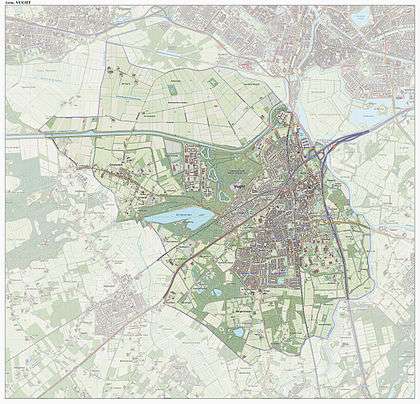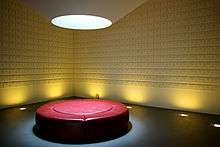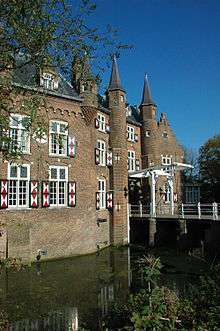Vught
| Vught | |||
|---|---|---|---|
| Town and municipality | |||
|
Church in Vught | |||
| |||
 Vught  Vught | |||
| Coordinates: 51°39′N 5°18′E / 51.650°N 5.300°ECoordinates: 51°39′N 5°18′E / 51.650°N 5.300°E | |||
| Country | Netherlands | ||
| Province | North Brabant | ||
| Government[1] | |||
| • Body | Municipal council | ||
| • Mayor | Roderick van de Mortel (VVD) | ||
| Area[2] | |||
| • Total | 34.44 km2 (13.30 sq mi) | ||
| • Land | 33.48 km2 (12.93 sq mi) | ||
| • Water | 0.96 km2 (0.37 sq mi) | ||
| Elevation[3] | 5 m (16 ft) | ||
| Population (May 2014)[4] | |||
| • Total | 25,769 | ||
| • Density | 770/km2 (2,000/sq mi) | ||
| Demonym(s) | Vughtenaar | ||
| Time zone | CET (UTC+1) | ||
| • Summer (DST) | CEST (UTC+2) | ||
| Postcode | 5260–5266 | ||
| Area code | 0411, 073 | ||
| Website |
vught | ||
Vught (Dutch pronunciation: [vɵxt]) is a municipality and a town in the southern Netherlands. Many commuters live in the municipality, and the town of Vught was once named "Best place to live" by the Dutch magazine Elsevier.
Population centres
- Cromvoirt
- Vught
Topography

Dutch topographic map of the municipality of Vught, June 2015
History
Early History
The first mention of Vught in the historical record dates to the eleventh century. By the fourteenth century, the Teutonic Order had acquired the parish and set up a commandery (feudalism) across from the Saint Lambert Church. In 1328, the residents of Vught were granted the right of municipality by the Duke of Brabant.
Eighty Years War
During the Eighty Years War Vught was the site of struggles between Catholic interests and the troops of William of Orange. The Saint Lambert Church was made into a Reformed Protestant church in the year 1629, after the troops of Frederick Henry, Prince of Orange, were victorious in 's-Hertogenbosch.
World War II
Vught is known for having been the site of a transit/concentration camp (Herzogenbusch) built by Nazi Germany during its occupation of the Netherlands in World War II. It was part of camp Herzogenbusch, but usually better known as "Kamp Vught" (Camp Vught). The camp held male and female prisoners, many of them Jewish and political activists, captured in Belgium and the Netherlands. The guard staff included SS men and a few SS women, headed by Oberaufseherin Margarete Gallinat. The SS initially used this location as a transit camp to gather mostly Jewish prisoners for classification and transportation to camps in Poland and other areas.
A group of women were severely punished for standing up for another female prisoner. Seventy-four women were pushed into a cell room of barely nine square meters and held there for over fourteen hours. Ten of the women died, and several suffered permanent physical or mental damage. The camp commander responsible was demoted by Himmler to the regular rank of soldier and sent to the Hungarian front; he died there in 1945.
Dutch underground members Corrie and Betsie ten Boom were held at Vught in 1944, before being sent to Ravensbrück concentration camp. Vugt was also a transition camp for many of the female laborers at the Agfa Kamerawerke in München-Giesing, where they built ignition and camera devises. Poncke Princen, who would later become known for going over to the Indonesian guerrillas opposing Dutch rule, was imprisoned at Vught for his anti-Nazi activities.
Vught was liberated by the Canadians at the end of the war, but only after German guards killed several hundred prisoners held there, mainly by firing squad.
Camp in post-war times

After World War II, the camp was first used as a prison for Germans and collaborators. Some of the camp has been preserved as a national monument related to the Nazi occupation during World War II. (See photo.)
The barracks of Camp Vught were later adapted into a number of home units to house Indonesian Moluccan exiles, former soldiers of the Netherlands armed forces and their families who were transferred to the Netherlands after Indonesian independence.
In addition, a prison called Nieuw Vosseveld[5] was built on part of the site of Camp Vught. In the beginning, it chiefly held young offenders. Today it is used for high-risk criminals. To this end, the prison was equipped with a high security unit, or EBI, in 1993.
Politics
On 2 April 2007 Roderick van de Mortel (VVD) was appointed mayor of Vught. The current aldermen are Peter Pennings (GB, also vice mayor), Saskia Heijboer-Klapwijk (VVD) and Wilbert Seuren (D66).
Landmarks and nature

Just outside the town border lies the lake IJzeren Man (literally translated Iron Man). It was named after the machine that dug it in the years 1890 to 1915. The sand was needed as fill for the expansion of the nearby city of 's-Hertogenbosch. The lake is about 2 kilometers long, has a small island and is now mainly used for recreation.
Vught has a castle, called Maurick; its history dates to the 13th century. In 1629 the castle was occupied by Frederick Henry, Prince of Orange. Frederick Henry wanted to have the castle as his headquarters for his siege of 's-Hertogenbosch. The castle has been adapted to house a restaurant, which has been recognised with one Michelin Star.
Ewald Marggraff
Ewald Marggraff was a well-to-do nobleman who lived in Vught in the twentieth century. He became a hermit, but had studied law and acquired a large amount of land and several buildings. He frequently argued with the local authorities, mostly over land issues. He chose to let all his properties deteriorate, which officials opposed, but letting his lands go enabled them to return to natural habitat. Animal species lived on his land that had disappeared elsewhere. His land holdings in and around the town of Vught were never open to the general public. On 7 December 2003 Marggraff's manor (Zionsburg) burned down; his body was found later in the entrance hallway near the front door.
Marggraff's surviving sisters founded a non-profit corporation, Marggraff stichting, to take over and manage their late brother's extensive landholdings for public use. The organisation has opened up the land for public access, allowing people from around the region to hike in the forests.
The non-profit also has plans to rebuild Marggraff's manor. In cooperation with SIX Architects BNA from Zeist, The Netherlands, it developed design and use plans, which are now under consideration by the local authorities.
Department of corrections — PI Vught
From 1953, part of the former detention camp was developed as a juvenile prison. Today it contains 15 separate units, holding 2400 prisoners. PI Vught has a prison with the status of a high-security unit. Amongst the criminals imprisoned there are:
- Samir Azzouz, terrorist with ties to Hofstad Network. Released in 2013.
- Mohammed Bouyeri, murderer of Theo van Gogh (film director). Serving a life sentence without parole.
- Willem Holleeder, one of the perpetrators in the kidnapping of Freddy Heineken. Released in 2012.
- Johan Verhoek, nicknamed de hakkelaar, drug dealer. Released in 2000.
- Curtis Warren, British drug trafficker. Released in 2007.
Transport
Vught has a railway station with connections to Amsterdam/Utrecht via 's-Hertogenbosch, Maastricht via Eindhoven, Tilburg and Nijmegen. Highway 2 / E25 and Highway 65 / N93 intersect at Vught. As well as two Arriva buslines connecting Vught to the Jeroen Bosch Hospital, school district and central station, all located in neighbouring Den Bosch.
Notable residents
- Jan-Hein Arens, painter
- Anton de Kom, Surinamese resistance fighter and anti-colonialist author
- Misha Geller, composer, violist
- Frank Houben, former governor of the province North Brabant
- Joost Prinsen, actor and television presenter
- Erna Spoorenberg, soprano
- Corrie ten Boom, Christian Holocaust survivor, who housed Jewish families in her home
- Betsie ten Boom, Corrie ten Boom's sister
- Maarten van der Vleuten, composer, producer, recording artist
- Albert Verlinde, Dutch TV host, producer of theater-shows
- Mina Witteman, writer
See also
- Joop Westerweel, resistance fighter during World War II
References
- ↑ "Burgemeester R.J. van de Mortel" [Mayor R.J. van de Mortel] (in Dutch). Gemeente Vught. Retrieved 7 June 2014.
- ↑ "Kerncijfers wijken en buurten" [Key figures for neighbourhoods]. CBS Statline (in Dutch). CBS. 2 July 2013. Retrieved 12 March 2014.
- ↑ "Postcodetool for 5261EP". Actueel Hoogtebestand Nederland (in Dutch). Het Waterschapshuis. Retrieved 7 June 2014.
- ↑ "Bevolkingsontwikkeling; regio per maand" [Population growth; regions per month]. CBS Statline (in Dutch). CBS. 26 June 2014. Retrieved 24 July 2014.
- ↑ http://www.pivught.nl/geschiedenis.html
External links
| Wikimedia Commons has media related to Vught. |
 |
Heusden | 's-Hertogenbosch |  | |
| Haaren | |
Sint-Michielsgestel | ||
| ||||
| | ||||
| Haaren | Boxtel |


